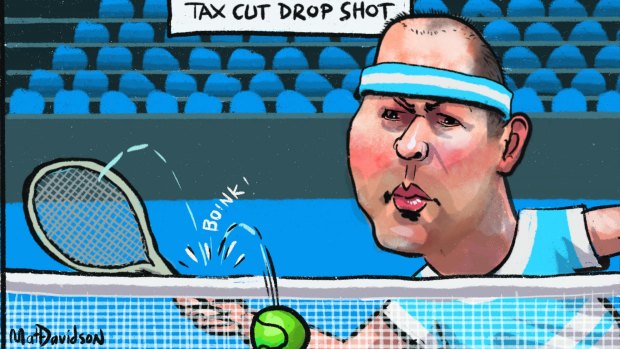This was published 5 years ago
Federal Budget 2019: Josh Frydenberg's $7.1 billion surplus has to be seen to be believed
By Peter Hartcher
There's an underlying political panic in this election-eve budget, like a scrabbling rodent running around inside, but it's caged in by just enough economic responsibility to keep it presentable.
It's not a blueprint for an ambitious reforming government but more like a lotto results sheet where favoured constituencies can find their winning numbers.
There's plenty of infrastructure spending to try to impress voters in regional seats, a car park construction fund for city voters who happen to live near train stations in marginal seats and promises of doubled tax relief for lower- and middle-income earners. Check the detailed tables for your lucky tax cut.
Here's a clue – if you're a taxpayer earning under $40,000, the government assumes you're not going to consider voting Liberal and if you earn over $120,000 it assumes you're not going to consider voting for anyone else.

Illustration: Matt Davidson.
But the budget still manages to tell a plausible story about a $7.1 billion government surplus, a surplus that remains exactly where it's always been in the last decade – almost within grasp, but not quite in the bank.
The Morrison government, like all the other governments of the past decade, call this "delivering" a surplus. They all suffer from a peculiar confusion that equates writing down a plan on a piece of paper with collecting large bundles of cash. Pardon our scepticism, Scott, but we will believe the surplus when we see it.
And yet, "by the standards of a pre-election budget, this is a reasonably responsible one," says Deloitte's Chris Richardson. "But that's a pretty low bar."
Specifically, says Industry Super chief economist Stephen Anthony, "Scott Morrison and Josh Frydenberg have been more considered on commodity prices than their predecessors."
For instance, much of the improvement in Australia's tax revenues this year is a result of a collapsed tailings dam at a Brazilian iron ore mine. The curbed output from Brazil pushed up the world price and, hey presto, billions materialise in the Treasury in Canberra.
The budget assumes the price of iron ore will fall back to its long-run average over the next year, which is more responsible than counting on further engineering disasters in South American jungles.
Illustrating just how important iron ore prices are to the national finances, the Treasury calculates that if the iron ore price should happen to return to its long-run average tomorrow instead of in a year's time, a third of the forecast surplus - $2.6 billion - would fail to materialise.
The scrabbling rodent remains underneath: "A huge part of the forecast surplus is because they've assumed lower cash payments" being paid out in the year ahead, "driven by parameters that aren't explained," says Anthony, a former Treasury budget examiner. "It's buried deep inside."
The tax plan stretches a decade into the future. There's an inherent implausibility in a government that's had three prime ministers in six years trying to tell you the exact number of dollars and cents in your tax cut a decade hence.
But this is plan for the next 10 years framed by the needs of the next six weeks uppermost in mind, by a government planning to call an election by next week.
In the immediate political play, we should regard this budget as tennis enthusiast Josh Frydenberg's return of the Labor tax cut serve.
Until now, Labor was promising to hand out 75 per cent more tax relief than the government. With this budget, Frydenberg is outmatching Labor and, asked if he's returning the Labor hit, replies, "Yes and this is more than that."
He seizes on the example of a teacher earning $100,000 who under the Coalition would be $1000 better off than under Labor. But the budget merely puts the ball back into the Labor court.
In his budget reply on Thursday, Bill Shorten will hit the tax cut ball back, and Labor has the capacity to hit it back even harder. Because Labor has announced some actual tax reform plans – to curb negative gearing and capital gains taxes, for instance – it has $200 billion more fiscal freedom than the government over 10 years.
The real question is whether, as the two teams go shot for shot to win the political point, whether there's anyone left in the stands. If you're in the right demographic, in the right seat, the government wants to promise you a tax cut and a car park, but does anyone believe enough to switch their vote as a result?
After the madness of the Coalition's leadership carry-ons and assorted outbreaks of chaos, is anyone even listening, or have the tennis fans all gone home? Politicians always think that giving people money will make them popular. Experts disagree.
"The polling has been strongly against the government now for a long time," says independent polling expert John Stirton, formerly longtime pollster for Nielsen. It's been almost three years, in fact. "It's the longest period of successive losses in Australian polling history. Pretty much nothing has shifted the polling, except in the wrong direction for the government."
Will promising people money change the trajectory and save the government? "As we get closer to an election, it's seen as a bit of a sign of desperation," Stirton says, "because it's done by a government in trouble. It's too late and it's too obvious."
Treasurer Frydenberg is a high-quality tennis player trying to give the government it's best shot, but he never did make it to the professional grade.